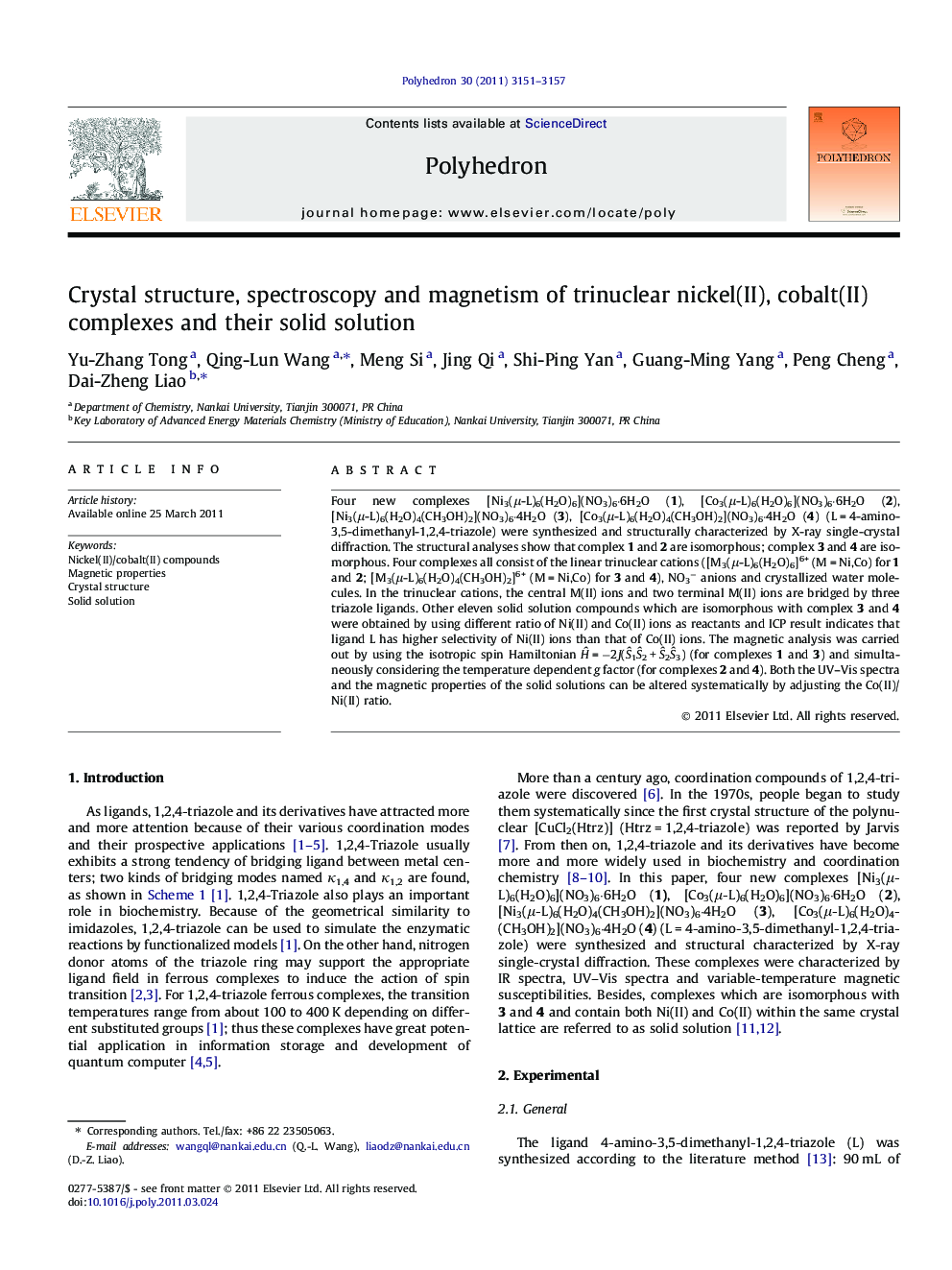| Article ID | Journal | Published Year | Pages | File Type |
|---|---|---|---|---|
| 1335998 | Polyhedron | 2011 | 7 Pages |
Four new complexes [Ni3(μ-L)6(H2O)6](NO3)6·6H2O (1), [Co3(μ-L)6(H2O)6](NO3)6·6H2O (2), [Ni3(μ-L)6(H2O)4(CH3OH)2](NO3)6·4H2O (3), [Co3(μ-L)6(H2O)4(CH3OH)2](NO3)6·4H2O (4) (L = 4-amino-3,5-dimethanyl-1,2,4-triazole) were synthesized and structurally characterized by X-ray single-crystal diffraction. The structural analyses show that complex 1 and 2 are isomorphous; complex 3 and 4 are isomorphous. Four complexes all consist of the linear trinuclear cations ([M3(μ-L)6(H2O)6]6+ (M = Ni,Co) for 1 and 2; [M3(μ-L)6(H2O)4(CH3OH)2]6+ (M = Ni,Co) for 3 and 4), NO3− anions and crystallized water molecules. In the trinuclear cations, the central M(II) ions and two terminal M(II) ions are bridged by three triazole ligands. Other eleven solid solution compounds which are isomorphous with complex 3 and 4 were obtained by using different ratio of Ni(II) and Co(II) ions as reactants and ICP result indicates that ligand L has higher selectivity of Ni(II) ions than that of Co(II) ions. The magnetic analysis was carried out by using the isotropic spin Hamiltonian Ĥ = −2J(Ŝ1Ŝ2 + Ŝ2Ŝ3) (for complexes 1 and 3) and simultaneously considering the temperature dependent g factor (for complexes 2 and 4). Both the UV–Vis spectra and the magnetic properties of the solid solutions can be altered systematically by adjusting the Co(II)/Ni(II) ratio.
Graphical abstractFour new 1,2,4-triazole complexes were synthesized and structurally characterized. Four complexes all consist of the linear trinuclear cations ([M3(μ-L)6(H2O)6]6+ (M = Ni,Co) for 1 and 2; [M3(μ-L)6(H2O)4(CH3OH)2]6+ (M = Ni,Co) for 3 and 4) (L = 4-amino-3,5-dimethanyl-1,2,4-triazole). Other eleven solid solution compounds which are isomorphous with complex 3 and 4 were obtained and ICP result indicates that ligand L has higher selectivity of Ni(II) ions than that of Co(II) ions. Both the UV–Vis spectra and the magnetic properties of the solid solutions can be tuned by adjusting the Co(II)/Ni(II) ratio.Figure optionsDownload full-size imageDownload as PowerPoint slideHighlights► Four new complexes [Ni3(μ-L)6(H2O)6](NO3)6·6H2O (1), [Co3(μ-L)6(H2O)6](NO3)6·6H2O (2), [Ni3(μ-L)6(H2O)4(CH3OH)2](NO3)6·4H2O (3), [Co3(μ-L)6(H2O)4(CH3OH)2](NO3)6·4H2O (4) (L = 4-amino-3,5-dimethanyl-1,2,4-triazole) were synthesized and structurally characterized by X-ray single-crystal diffraction. ► Eleven solid solution compounds which are isomorphous with complex 3 and 4 were obtained by using different ratio of Ni(II) and Co(II) ions as reactants and ICP result indicates that ligand L has higher selectivity of Ni(II) ions than that of Co(II) ions. ► The spin Hamiltonian is insufficient to treat the Co(II) multinuclear complex. Here we use an approximate method to interpret the magnetic behavior for complexes 2 and 4. The magnetic analysis was carried out by using the isotropic spin Hamiltonian Ĥ = −2J(Ŝ1Ŝ2 + Ŝ2Ŝ3) and simultaneously considering the temperature dependent g factor.
